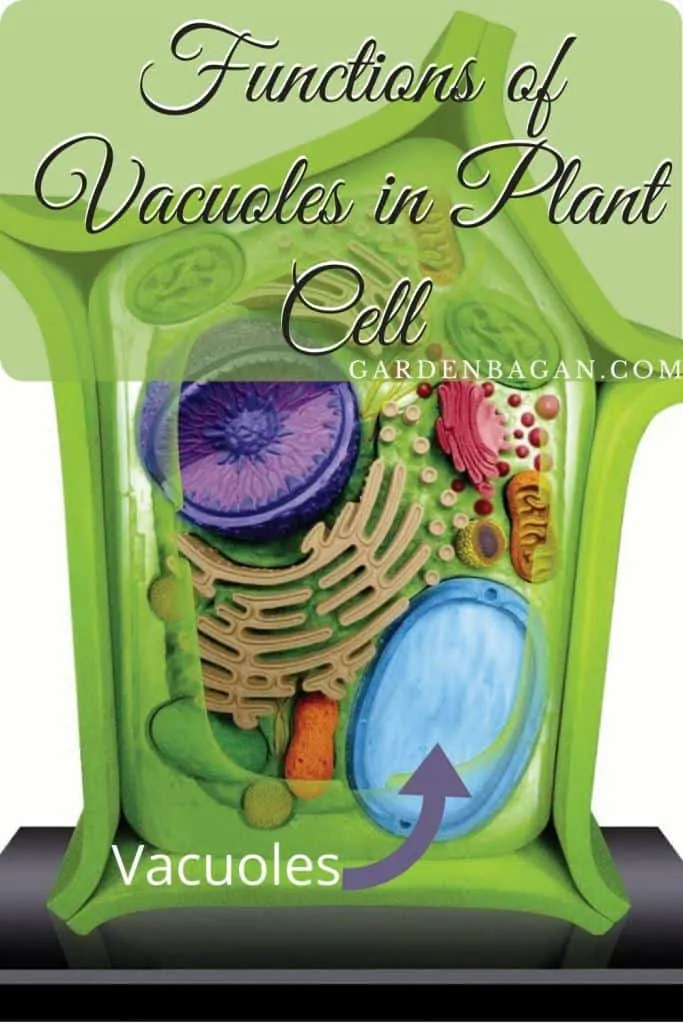Vacuoles are membrane-bound cell organelles. They are present in both plant and animal cells. Vacuoles are sack-like flexible structures filled with water. Vacuoles play an important role in the functioning of every cell. Today we will discuss some important functions of vacuoles in a plant cell.
What is the main function of vacuoles?– Collecting, Storing, and Removal of unused waste materials are the main function of vacuoles.

check out: 20 Weird things a Garden Frog can Eat. Backyard facts
What is the role of vacuoles in plant cells?
Vacuoles provide turgidity in the plant cell. Even the dead plant cell contains vacuoles providing space for air and water columns.
Vacuoles maintain the ph level inside the cell cytoplasm. It also regulates the osmotic pressure to exchange food and waste materials.
10 Vacuole functions in Plant
- Isolating harmful materials from other cell organelles.
- Separate and store the waste products after consumption.
- Store extra water in plant cells. Vacuoles also help in maintaining osmotic pressure inside the cell.
- Maintaining internal hydrostatic pressure or turgor within the cell. Turgidity is important to keep the plant standstill. This also helps the plant to create collective turgor pressure for the intake of water and minerals.
- Maintaining an acidic internal pH. A slight change in internal Ph can dissociate the organelles and break the cell structure. Vacuole plays an important role in balancing the right ph throughout cell life.
- Containing small molecules. Sometimes unused food particles or mineral particles can be a store within vacuoles. These are either leftover or discarded tiny particles. The cell can use it if required can remove whenever needed.
- Removal of waste material from the cell. At the cellular level vacuoles play an important role in waste management.
- It allows plants to support structures such as leaves and flowers due to the pressure of the central vacuole. The central Vacuole in a plant cell is one of the largest cell organelles. Rearranging the position and size of the organelles can greatly affect the size and structure of the plant.
- Vacuoles take an active part in seed germination. It can store extra water to expand the size of the cell. This helps in faster growth in seedlings and leaves.
- The Protein Body or modified vacuoles in seeds store amino acids and proteins essential for germination. These modified vacuoles are responsible for saving life within a seed for years.
How does the vacuole contribute to cellular growth in plants?
Seed germination to flowering and fruiting, A vacuole has many contributions to cellular growth in plants.
At initial stages, a modified vacuole called “Protein Body” provides essential protein for the germination of seeds. Next, some vacuoles expand quickly by absorbing more water and help in quick cell growth. This is why the growth of plants in the initial stages is faster than the mature plant.
Later the large central vacuole in each plant cell provides a rigid structure. Collectively the vacuoles are responsible for giving a plant its definite structure.
The vacuoles also contribute to creating turgor pressure from roots to the tip of the plant. This is an upward pressure that forces the water and mineral to move upward toward the leaves and branches. A rapid drop in turgor pressure can be observed as drooping in plants especially during summer days.
Apart from these visible contributions, vacuoles have some important hidden contributions. These functions greatly affect the life cycle and sustainability of every plant cell. Some of these functions are the removal of unwanted molecules. Dead or damaged cell organelles are removed from the cell to keep it healthy. This phenomenon is often called autophagy.
Next is Biogenesis. Do You Know? Some modified Vacuoles helps the cell to repair and regenerate dead or damaged Organelles. This is a very important functioning of a Vacuole.
vacuoles provide structure not only to living cells but also to the dead plant cell. This helps the plant to attain a height and maintain turgidity.
Vacuoles also help in decomposing the cell itself on being infected or damaged. Lysosomes are one Important modification of Vacuoles in Animal cells. Do plants have lysosomes? Everything to Know
Do all plant cells have vacuoles?
Yes, all plant cells have Vacuoles. The central vacuole in a plant cell is one of the largest cell organelles. The structure of the plant cell is maintained by this central vacuole.
What is the type of vacuoles present in Plant cells?
There are mainly three types of cell vacuoles present in a plant cell. These are Central or sap vacuole, Contractile vacuole, food vacuoles responsible for phagocytosis.
The central vacuole is also called a sap vacuole. It is the largest vacuole in plant cells. It Mostly contains water and maintains the structure of the cell.
Contractile vacuoles are responsible for the proper removal of waste materials. These vacuoles are also important in maintaining the osmotic pressure and turbidity of the cell.
Food vacuoles store the materials often called as food particles for the cell. These particles are mostly complex compound used to process nutrients.
How many Vacuoles are Present in Plant?
The number of vacuoles varies from one cell to another. In a typical plant cell, there is at least on central vacuole present. Other than this vacuole there may be 10-50 more vacuoles present in each plant cell. 30% to 80% by volume of a plant cell is the vacuole.
What do you think- What are the Important Functions of Vacuoles in Plant Cell? Write your answer or suggestions in the comment section. Keep reading Keep gardening.
Reference:

I agree with your points, excellent post.